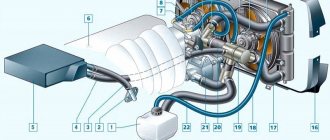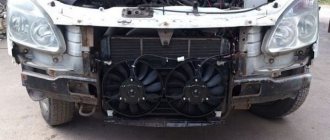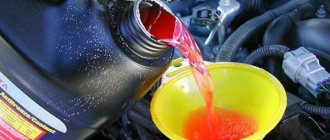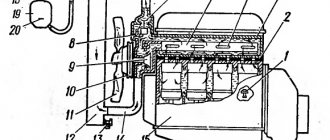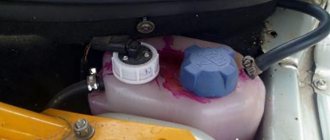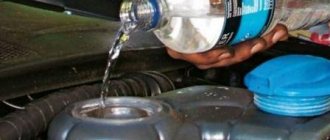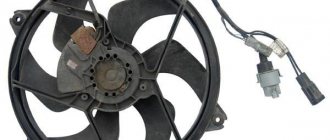According to the manufacturer's recommendation, the coolant should be replaced after two years of operation or after 60 thousand kilometers, whichever comes first. In addition, if the coolant changes color to a reddish color, replace it immediately, as such a change indicates that inhibitory additives have developed and the liquid has become aggressive towards the parts of the cooling system.
You will need: a 13mm wrench, a container for draining coolant, coolant, a funnel.
Use coolants recommended by the manufacturer (see Appendix 2).
Replace coolant only when the engine is cold.
Coolant is toxic, so be careful when handling it.
When starting the engine, the expansion tank cap must be closed. Screw the expansion tank cap tightly. The expansion tank is under pressure when the engine is running and therefore, if the plug is loosely tightened, coolant may leak from under it.
1. Open the heater valve by moving the control lever to the right until it stops.
2. Place a container under the drain plug of the radiator of the cooling system and unscrew the plug.
3. Remove the cooling system expansion tank cap by turning it counterclockwise.
4. Remove the plug from the drain hole on the cylinder block and drain the remaining coolant from the channels of the cylinder block, first placing a container under it. Tighten the plug.
5. Fill the engine cooling system by pouring coolant into the expansion tank until the level is at the top edge of the expansion tank mounting belt. Close the expansion tank cap. Start the engine and let it warm up to operating temperature (before turning on the fan). After this, stop the engine, check the coolant level and, if necessary, add to the level of the upper edge of the reservoir fastening belt.
With the engine running, monitor the coolant temperature according to the gauge. If the arrow reaches the red zone and the fan does not turn on, turn on the heater and check what kind of air flows through it. If the heater supplies heated air, it means that the fan is most likely faulty (contact a specialist), and if it is cold, it means that an air lock has formed in the engine cooling system. To remove it, turn off the engine, let it cool and unscrew the expansion tank cap. Start the engine, let it run for 3-5 minutes and close the expansion tank cap.
After a few days of using the car after replacing the coolant, check its level. If necessary, add coolant.
If, after a very short time, fresh antifreeze changes color from blue to brown, it means that you filled it with a fake, to which the manufacturers “forgot” to add corrosion inhibitors. In addition, one of the signs of a fake is the sudden complete discoloration of antifreeze. The dye of high-quality antifreeze is very stable and only darkens over time. Antifreeze tinted with linen blue becomes discolored. This “antifreeze” needs to be replaced quickly.
Read more: Headlight fogged up after washing
This video will show how easy it is to replace antifreeze, Oka will not give any difficulties with this. It’s easy to change antifreeze or other coolant on the Oka with your own hands.
How to change Oka antifreeze
First, you should open the heater tap by moving the lever in the cabin to the right all the way. Then place a container under the radiator where the coolant will drain. After this, you need to unscrew the drain plug on the radiator and remove the cap on the expansion tank . You should also drain the fluid from the cylinder block by unscrewing the drain bolt.
After draining the liquid and tightening the drain plugs on the radiator and cylinder block, you need to install a funnel and pour new antifreeze or antifreeze into the expansion tank to the top edge. Then start the engine and let it warm up to operating temperature so that the fan turns on. Now all that remains is to check the fluid level in the tank and top up if necessary.
This video with instructions will help you see how to replace the coolant on an Oka car.
› Logbook › Replacing the cooling system with OKE
In the spring, problems began with the cooling system and almost everything else. One by one, the hoses began to tear and burst, followed by the radiator, and then the pump and the heater radiator. During all this time, I collected the material that I present and repaired it.
When we bought the car, the radiator was already leaking, a replacement was made, and when I drained the coolant, there were some kind of liquid granules in it, some kind of sealant was bubbled up so as not to bother. I installed a new radiator and filled in new antifreeze! Not even thousands of kilometers later, the radiator started leaking again - a new radiator! The hoses swell, burst and leak - I started thinking - “Isn’t excessive pressure being created in the cooling system?!” Moreover, I changed the plug on the expansion tank. I replaced the hoses with the thermostat, basically everything except those going to the stove, radiator and thermostat!
The next thing to fail was the pump - in the mornings a puddle appeared under the car, a ringing sound appeared from the right side of the engine, and antifreeze began to leak from the expansion tank. It got to the point where a stream began to flow from the side of the pump.
Not even a day had passed before there was a puddle in the cabin on the right
Under the panel it is difficult to determine exactly where the leak is - the faucet, the heater radiator itself or in the connections. I had to remove everything, I immediately replaced the faucet and gaskets
At the same time I decided to check the heater radiator for air tightness. I plugged one hole with a bolt and an elastic band, and inserted a pipe from a tubeless tube into the other hole, which was pressed tightly with a seal cut from an old faucet - it turned out airtight.
Read more: Rear window wiper does not work
Pumped it up decently, checked with a soap solution to see if there was a leak
There were no bubbles, I left it overnight. The next day I checked whether there was air in the radiator by pressing the spool valve - a stream of air was knocked out, the pressure remained the same. I collected everything, warmed up the engine - and again there was a puddle on the floor! The conclusion is the following: when heated, the bodies expand, and if there was a hole in the radiator, then when the radiator is filled with cold air, there is no leakage, but when the body warms up from antifreeze, the metal expands, the hole increases and liquid leaks. Back to the store.
Each time I filled in new antifreeze, it’s not an expensive thing, but the ambush is still ahead. My traffic jams are easily cleared if I run my front wheels over a small bump: I run over it, turn the heater on full and wait until the hot air comes out! The plug is expelled without waiting for the fan to operate. The hoses that go to the heater (heater radiator) were covered next.
Well, everything seemed to be new, but the antifreeze began to darken. As soon as the fan starts working - DARK COOLING. Maybe the hoses are stained, I decided to wash them the old-fashioned way:
I noticed that the water did not darken, but I was afraid that the cylinder block would rust. I fill it with antifreeze and the same thing happens again - it gets dark. Antifreeze does not get into the oil, everything is clean. I decided to replace the pump pipe and the intake pipe gasket.
.and again an ambush. The rivers of antifreeze have already flowed away, I changed the stores where I bought it, it’s still getting dark. It seems like a big deal to drive around like that, but how much does everything new cost?
I accidentally went to the official website of Dzerzhinsky antifreeze, they write there that there are a lot of fakes, and their topic is TOSOLSINTEZ. It was decided to completely switch to antifreeze.
I washed it like this: put a bucket of water on the roof, put a hose from the bucket into the expansion tank by gravity, all the plugs are open.
I washed everything properly and filled it with green FELIX antifreeze. Everything is branded and original. Nice packaging. While I'm driving, I'm watching.
Issue price: 5,000 ₽
Cooling system for OKA VAZ-1111 - 1113 cars
The cooling system in OKE is liquid, closed type, with forced circulation. The tightness of the system is ensured by the inlet and outlet valves in the expansion tank plug. The exhaust valve maintains pressure in the system when the engine is hot (due to this, the boiling point of the liquid increases and steam losses are reduced), it opens at a pressure of about 110 kPa (1.1 kgf/cm2). The intake valve opens when the pressure in the system decreases relative to atmospheric pressure by 3-13 kPa (0.03-0.13 kgf/cm2) (on a cooling engine). The thermal operating conditions of the engine are maintained by a thermostat and an electric radiator fan. The coolant pump is a vane, centrifugal type, driven from the crankshaft pulley by a timing belt. The pump housing is aluminum. The roller rotates in a double-row bearing with a “lifetime” supply of lubricant. The outer ring of the bearing is locked with a screw. A toothed pulley is pressed onto the front end of the roller, and an impeller is pressed onto the rear end. A thrust ring made of a graphite-containing composition is pressed to the opposite end of the impeller, under which there is an oil seal. If the pump fails, it is recommended to replace it as an assembly.
Cooling system: 1 — expansion tank plug; 2 - expansion tank; 3 - steam removal hose; 4 — radiator supply hose; 5 — engine radiator; 6 — fan impeller; 7 — radiator casing; 8 — sensor for turning on the electric fan; 9 - drain plug; 10 — timing belt; 11 — coolant pump; 12 - pump suction pipe; 13 — heater supply pipe; 14 - tap; 15-outlet heater pipe; 16 — heater radiator; 17 — coolant temperature sensor (at the left end of the cylinder head); 18 — hose for removing coolant from the cooling jacket of the inlet pipe; 19 — radiator outlet hose; 20 — exhaust pipe of the block head; 21 — filling hose; 22 — thermostat; 23 - pump suction pipe hose.
The redistribution of liquid flows is controlled by a thermostat with a solid heat-sensitive element. On a cold engine, the thermostat valve closes the pipe leading to the radiator, and the liquid circulates only in a small circle (through the thermostat bypass pipe), bypassing the radiator. The small circle includes the heater core and the intake pipe. At a temperature of 87±2°C, the valve begins to move, opening the main pipe; in this case, part of the liquid circulates in a large circle through the engine radiator. At about 102°C, the main valve opens fully and the bypass valve closes, allowing all fluid to circulate through the engine radiator. The stroke of the main valve must be at least 8 mm.
The engine radiator consists of two vertical plastic tanks (the left one has a baffle) and two horizontal rows of round aluminum tubes with pressed-on cooling plates. To increase cooling efficiency, the plates are stamped with a notch. The liquid is supplied through the upper pipe and discharged through the lower. Next to the inlet pipe there is a thin pipe for the steam removal hose.
The electric radiator fan is switched on via relay 113.3747 by a TM-108 sensor-switch screwed into the right radiator tank. Its contacts close at a temperature of 99±3°C and open at 94±3°C. The relay is located under the instrument panel on the left. Its characteristics are described in the “Electrical equipment” section.
The expansion tank is made of translucent polyethylene, which allows you to visually monitor the liquid level. In its upper part there is a fitting for the steam removal hose from the engine radiator, in the lower part there is a fitting for the filling hose.
To monitor the coolant temperature, a sensor is screwed into the engine cylinder head, which sends a signal to the temperature gauge of the dashboard. The heating system is described in the chapter “Heating and ventilation system”.
see also
Comments 12
I can’t say about authenticity, but the pump still doesn’t upset me! Not a hint of noise or leakage! If you look closely, there is also a seal on the box! Previously there were TZA spare parts, now LADA-DETAL is also Lada image!
I don’t want to upset you, but judging by the box and gasket, the pump is fake. But maybe I'm wrong. Maybe there were boxes like this before, with such quality of printing and the gaskets weren’t made from beech...
Yes, the work of identifying the defects of the cooling system is such a thing that, well, what the heck!
Can you tell me which VAZ the radiator hoses come from? I need the bottom one and go urgently, and then you’ll see that all the others will be replaced))
Oka only comes with Okovsky pipes, (see photo) but the thermostat costs from 2108, there is an option that will fit from it, but the original pipes are already bent from the beginning and cast in the same shape as needed! It seems to me that if you adjust it from something else, it may leak at the connection points! I got confused with my family, they seem the same, I installed them without looking, but during assembly it either rests on the clutch cable or on the cooling fan nut! I think it’s easier to find and install original shackles... Good luck!
Read more: Is it possible to drive a bun with poppy seeds?
Oh oh, I’ll go to the car market and then I’ll look for the necessary pipes there! thanks for the advice
I see that Okushki's cooling system is a sore subject. Since the spring, I’ve also been changing mine one by one, although so far only the pipes. But antifreeze also dripped into the cabin, exactly the same, I also changed the tap and hoses. The radiator, pump and thermostat are still normal.
I haven’t written for a long time because I was testing the installed new LADA DETAIL thermostat! There are still no severe colds, but after I installed everything, it was immediately cured! The need to cover your face immediately disappeared! Even in the cold, while driving, I turn off the heater fan, open the heater radiator hatch below the panel, and it’s so warm that the melted water from my feet practically dries up! It's very warm in the cabin! I repeat - no cardboard boxes or radiator barriers! The machine heats up quickly and maintains the set temperature!
Right now the problem is a little different - I installed a Finnish thermostat in the spring (well, I think with their climate it should work as it should) all summer it worked as it should, but the cold weather set in, snow fell, it was -10C* outside the window and if you go on a long trip, the temperature does not heat up more than 70C* - it’s not cold in the cabin, the eyes don’t sweat, the engine is warm, the hoses are warm, but it doesn’t heat up and that’s it! I inserted a piece of cardboard in front of the radiator and everything was fixed; the temperature arrow climbed to 90C* - the cabin is warm, I don’t even use the heater button! But a day later everything melted, outside the window it’s plus 10C* - there’s a bathhouse in the car, it’s just not real hot, driving around the city - the sensor goes off every now and then, the fan turns on - and even the light is on - the speed drops, the engine barely revs. I took out this cardboard and everything was normal again! Moral: before this it was OKA, I don’t know what kind of thermostat it was, but I didn’t install any cardboard boxes at all, I didn’t even move the winter-summer lever on the air filter, because the corrugation fastening on my pants had fallen off! And it was filled with ordinary antifreeze. Now I’m thinking: either it’s because the radiator and the entire cooling system are new, everything is well ventilated and cools quickly, or the thermostat is stuck and in cold weather of about thirty degrees it won’t be ice, especially with frozen windows! I’ve already bought a new LADA DETAL thermostat, I’m thinking about replacing it, without cardboard it’s somehow more convenient in any weather!
How much oil is in an Oka engine ~ VESKO-TRANS.RU
How much oil to pour into the eye and how to do it correctly
Many drivers are interested in how much oil to fill in the Oka. Naturally, this question is of greater concern to those who use the VAZ-1111 car and its other modifications. Or those whose loved ones (for example, someone from the older generation) purchased such a car.
The Oka car manufacturer recommends using certain types of oils.
Oka's car has a lot of modifications. Not all of them went into the general creation, but several hundred samples were still sold. Depending on which of them you are dealing with, you can accurately determine the engine size. For example, the first Oka cars (VAZ-1111 and similar) have a crankcase filling volume of 2.5 liters. What is a crankcase? This is the name given to a car part that protects its most important parts. This is a gearbox, various engine parts that are in motion, etc. The crankcase not only protects, but also lubricates those machine parts that are in motion.
Invented relatively recently (in 2007), Oka trucks need, of course, to be filled with more oil. About 4 liters
It is equally important to do it the right way. Let's consider the rules for pouring oil into a passenger car.
According to the manufacturer's recommendations, you need to use certain types of this liquid. Let's consider, as an example, how to change it for a VAZ-1111 car.
Breakdowns and leaks of coolant from the reservoir
The cooling system in the Oka car performs the function of protecting the engine from overheating. In addition, the CO provides comfortable transport control in the summer and winter seasons. At the heart of the mechanism, the active substance is a special process fluid - antifreeze or refrigerant.
The coolant circulates through the CO system, evenly distributing heat or heating the engine at the desired temperature. At the same time, the solution also effectively lubricates the surface of the water pump, protecting it from wear. The liquid contains special anti-corrosion additives, which over time can lose their properties. Residues of metal particles become clogged in the pipes, which can lead to failure of the CO and liquid leakage. It is dangerous to drive such a vehicle, so drivers are advised to regularly check the coolant level in the system.
In order to check the antifreeze level in an Oka car you need to:
- remove the dipstick from the hole in the expansion tank;
- wipe the surface with a clean sponge;
- insert the part back;
- lower the dipstick into the crankcase until it stops;
- remove the mechanism and carefully inspect the contents.
Coolant change process
In the VAZ 11113 Oka, the coolant is most often replaced by drivers themselves. This does not require any professional skills. You just need to purchase the required solution, prepare the tools according to the list and follow the step-by-step instructions outlined below.
In order to determine which antifreeze to buy, you should read the technical documentation of the vehicle. Oka car manufacturers recommend using the following brands of coolant:
Substance viscosity - API SJ/CF, SAE SG/CD and SJ/SH/CD.
Required tools:
- wrench 8;
- standard Phillips screwdriver;
- hexagon No. 12;
- funnel;
- clean rags;
- empty container for draining used antifreeze.
Step-by-step instructions for replacing coolant in an Oka car:
- Initially, you need to drive the car into the inspection hole and turn off the engine;
- Open the hood and unscrew the expansion tank valve;
- Open the heater drain valve and turn it to the extreme right position;
- Unscrew the bolts and remove the crankcase protection;
- Remove the radiator valve, placing a container under it;
- Drain the fluid from the cylinder block and tighten all valves;
- Loosen the carburetor clamp and disconnect the heating hose;
- Fill the expansion tank under the hood with antifreeze to the maximum mark;
- Start the engine for 10 minutes and check the coolant level in the system.
